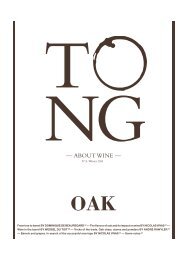here - Tong Magazine
here - Tong Magazine
here - Tong Magazine
- No tags were found...
Create successful ePaper yourself
Turn your PDF publications into a flip-book with our unique Google optimized e-Paper software.
TONG N° 9German Riesling is experiencing a renaissance, about which a great deal hasrecently been written. For 40 years after the Second World War, Riesling was alow-quality, mass-produced wine with a poor image, but after hard work by winemakersacross the country, it is making it onto the world’s top wine lists again.Romana Echensperger has worked for 12 years as a sommelierin high-end restaurants in Germany. In 2005, she was elected“Best Sommelier of Berlin”, working from a list of 1,000 Germanwines. From 2007 to 2010, she was head sommelier at thethree-star restaurant Vendôme near Köln, which was selected“Best Restaurant of Germany”. Echensperger is a second-yearMaster of Wine candidate.Needless to say, nothing is perfect. The cacophony oflabel descriptions in particular has been understandablydiscussed and criticised, although I would argue,what’s the point of trying to straightjacket such a diverseproduct?German Riesling is diverse in a variety of ways: eachregion has its history and winemaking traditions; singlevineyards have different microclimates and soils, makingfor multiple combinations of this highly sensitive grape variety;wine styles vary from bone-dry to every imaginablesweetness level; and last but not least, ageing behavioursvary, offering an underestimated opportunity to bring morecolour into the world of Riesling.Riesling performs best in cool climates. The plant isfrost-resistant thanks to its hard wood and late budding.Usually an early-ripening grape variety, the diverse Germanwine regions provide the long and cool ripening periodneeded to bring out the flavours and berry extract.This and the immense diversity of single vineyards, eachwith its own microclimate and soil, explain (together withwinemaking practices, of course) remarkable taste differencesand characters.Riesling can show potential and typicity at very differentyield levels. Severe pruning and green harvest aren’trecommended. The berries grow thicker, skin-to-pulp ratioisn’t optimal and the berries can burst. A very good andbalanced and sweet Kabinett needs a yield of some 60-70 hl/ha. Dry wines like “Grosses Gewächs” need moreconcentration, and a lower yield of around 40 hl/ha.Diversity of soilsand minerality in wineWhen describing wine, minerality is always a keyword, although t<strong>here</strong> is no scientific proof of a direct linkbetween the soil and the taste of a wine. This is a controversialtopic, and I would need a very long separatearticle to discuss it in detail. I’d nonetheless like to mentionProfessor Otmar Löhnarz (University of Geisenheim)and his scientific project called “Terroir Hessen”. For theproject, Riesling was grown on different soil types. It washarvested with the same yield, the same ripeness level,and all the wines were fermented with the same yeastand using the same winemaking techniques. The resultwas predictable: each wine tasted different, but the differencein mineral content wasn’t measurable. Soil appearsto have only an indirect impact on a wine’s aromas.It does, however, influence microclimate. Take for instancethe Mosel’s black slate soil that collects the sun’s- 04 -





